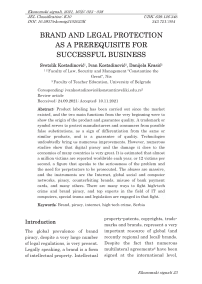Brand and legal protection as a prerequisite for successful business
Автор: Kostadinović Svetolik, Kostadinović Ivan, Krasić Danijela
Журнал: Ekonomski signali @esignali
Статья в выпуске: 2 vol.16, 2021 года.
Бесплатный доступ
Product labeling has been carried out since the market existed, and the two main functions from the very beginning were to show the origin of the product and guarantee quality. A trademark or symbol serves to protect manufacturers and consumers from possible false substitutions, as a sign of differentiation from the same or similar products, and is a guarantee of quality. Technologies undoubtedly bring us numerous improvements. However, numerous studies show that digital piracy and the damage it does to the economies of many countries is very great. It is estimated that almost a million victims are reported worldwide each year, or 12 victims per second, a figure that speaks to the seriousness of the problem and the need for perpetrators to be prosecuted. The abuses are massive, and the instruments are the Internet, global social and computer networks, piracy, counterfeiting brands, misuse of bank payment cards, and many others. There are many ways to fight high-tech crime and brand piracy, and top experts in the field of IT and computers, special teams and legislation are engaged in that fight.
Brand, piracy, internet, high-tech crime, Serbia
Короткий адрес: https://sciup.org/170204048
IDR: 170204048 | DOI: 10.5937/ekonsig2102023K
Текст научной статьи Brand and legal protection as a prerequisite for successful business
The global prevalence of brand piracy, despite a very large number of legal regulations, is very present. Legally speaking, a brand is a form of intellectual property. Intellectual property-patents, copyrights, trade— marks and brands, represent a very important resource of global (and recently regional and local) brands. Despite the fact that numerous multilateral agreements4 have been signed at the international level, there is still no unified global legal framework for the protection of intellectual property.
Traditionally, legal trademark protection has been of paramount importance for brand protection. [Dašić, 2014] However, in recent years, with the internationalization and transparency of the Web, it has become very difficult to monitor all legal aspects of the brand. Many well-known brand owners have a lot of problems with websites that use their brand names or similar things.
For example, the issue of copyright protection was not determined until the end of the Middle +ges. This issue was made relevant only after the invention of the printing, because only in that way was it possible to abuse and infringe copyright on a broad basis.
The Kingdom of Serbia is one of the first signatories to the Convention on the Protection of Intellectual Property. Insight into the database of the current Institute for the Protection of Industrial Property of the Republic of Serbia, it can be seen that the first applications were submitted to the then Directorate for the Protection of Industrial Property in 1921, and accordingly, in Serbia (during the twenties of the XX century) some of the most famous brands of today were registered and protected, such as:
Gillete, Colimbia, Mercedes, Thermos, Ford, Dictaphone, Warta, Singer, Remington, Goodyear, DuPont, Cadillac, Palmolive, Buick, Johnnie Walker, etc. The first domestic registered brand, together with the design solution, was LIKO-S+N soap, of the factory Merima from Kruševac. The application number was 1931/00000411, and the date of submission for registration of this brandmark was +ugust 26, 1931.5
The legal environment is most pronounced in more than one country due to differences in the settings of legal systems. Problems can occur especially with companies that are trying to 6ointly formulate a (standardized marketing) plan that they would implement in several countries. +lthough differences in language and customs can be more easily overcome today, differences in the legal environment can significantly impede the standardization of the overall marketing program. Each country has legal specifics that regulate promotion, product development, labelling, pricing and distribution channels.
1. Intellectual property protection and rights
The increase in the number of similar products and services leads to increasing mutual exchange of offers within different industries. Intellectual property is the name for the generic concept of products of the human spirit - intellectual properties, created by innovators and creators (authors and inventors) and which represent a special form of ownership of intangible assets. The progress of human society is based on inventions, innovations and the creation of new products and services. In this way, authors and inventors represent the key to human development, progress and the well-being of humanity. Their activities require huge personal and financial investments, and the results of that work are in the general interest of society, so it is necessary to legally protect the holders of intellectual property. [Perinčić, 2016]
In the Republic of Serbia, the system of protection of IP rights is based on:
-
(1) the laws governing each area of IS separately;
-
(2) bylaws;
-
(3) ratified international treaties.
Thus, there are special laws that materially regulate the areas of copyright and related rights and industrial property rights (patent, industrial design, trademark, designation of geographical origin, topography of a semiconductor product and plant variety protection, etc.). Basic laws have been adopted for the following areas of IS: [BCRR, 2021]
-
(1) Law on Copyright and Related Rights ("Official Gazette of RS", No. 104/2009, 99/2011, 119/2012 and 29/2016 - US decision -hereinafter: LCRR);
-
(2) Law on Patents ("Official Gazette of RS", No. 99/2011, 113/2017 O st. law and 95/2018);
-
(3) Law on Legal Protection of Industrial Design ("Official Gazette of RS", No. 104/2009, 45/2015 and 44/2018 - state law);
-
(4) Law on Trademarks ("Official Gazette of RS", No. 104/2009, 10/2013 and 44/2018 O st. law;
-
(5) Law on Geographical Indications ("Official Gazette of RS", No. 18/2010 and 44/2018 - st. law);
-
(6) Law on Protection of Topographies of Semiconductor Products
"Official Gazette of RS", no. 55/2013);
-
(7) Law on Protection of Plant Pari-ety Breeders' Rights, "Official Gazette of RS", no. 41/2009 and 88/2011);
-
(8) Law on Optical Discs ("Official Gazette of RS", No. 52/2011 of 15 July 2011).
Product labelling has been carried out since the market existed, and the two main functions from the very beginning were to show the origin of the product and quality guarantee. Defining a brand has evolved over time, so the concept of a brand is increasingly associated with both visible and invisible elements. + brand represents the way in which the consumer sees, perceives and understands a particular branded product, service, destination, country or person in all its dimensions, and for the company it is a de facto part of the property, because it has value in itself. [Dašić, 2016]
Everything that carries a certain value is sub6ect to copying and various other elements. + brand name is a part of a brand that can be pronounced. [Dašić et al., 2021] + brand mark (if it is also legally protected, a trademark) is a part of a brand that cannot be pronounced, but the visual identity of a product, service or company is recognizable. Brand colour represents a colour or combination of colours characteristic of a particular brand and brand image represents a sub6ective image of the ob6ective reality that the consumer has about a particular brand.
+ trademark is a legally protected and registered brand. It can refer to a name, a symbol or a design. The trademark consists of two parts: the mark itself, a list of goods and services to which it applies and for which it is protected.
+ trademark is a mark used in trade or intended for that trade, in order to distinguish the goods of one economic organization, institution or other legal entity from the goods of the same or similar type of another organization, which is protected by law.
+ service mark is a mark used by an organization for the provision of services in commercial transactions, in order to distinguish its service activities from the same or similar service activities of another organization, and which is protected by law.
+ny sign suitable for distinguishing in the economic turnover of goods or services may be used as a trademark. The character or name of a person, state or other public coat of arms, flag or emblem or their support, name or abbreviation of the name of a country of an interna- tional intergovernmental organization may be protected as a trademark only with the consent of that person or the competent authority of that country or organization and in the case of the character or name of the deceased, with the consent of his spouse, child or parent.
+ny distinctive word, letter, number, drawing, image, shape, colour, logos, labels or combinations thereof can be legally protected. In some countries, advertising slogans may also be considered trademarks and may be registered with the National Trademark Office. Recently, an increasing number of countries allow the registration of special forms of trademarks, such as: one colour as a mark, three-dimensional signs (and/or shape of products or packaging), sound signs (sounds) or odour signs (smells). However, many countries have adopted restrictions on what can be registered as a trademark, in general this is only possible for signs that can be visually observed or can be graphically represented. [Pel6ković, 2010, 10]
The symbols of the brand increase its recognizability and persuasiveness. The symbol can be treated as a permanent identity element of the brand, and can be further selected and used during promotional campaigns. In the function of permanent identity recognition of the brand, many companies resort to finding striking symbols in the form of: mascots, signs, animated characters, living beings, interesting ob6ects, etc. (Figure 1)
Figure 1. Some ofthe best characters used in branding in the 20th century


The Michelin Man - 1898
The Marlboro Man - 1955


+unt Jemima - 1893
Roland McDonald - 1963
Source: (1.9.2021)
Many authors in the field of branding, [+džić, 2021; Dašić & Dašić, 2021; Zečević, 2021] believe that one of the main functions of branding is their efficient and convincing power of differentiation in relation to the competition. + brand is something that companies can use to compete with the multitude and be recognized and acknowledged by potential customers but is very susceptible to copying (Table 1). Brands reduce business risk because they convey a certain image of a product, service or company. [Dašić, 2018]
2. Protection of designations of origin and geographical origin
+ designation of origin is the name of an area, place or, in special cases, country used to denote products or services originating in that area, place or country and whose quality or characteristics are influenced by special natural and human factors of a particular geographical environment. The production, processing and preparation of these products takes place entirely in that geographical area.
+ geographical indication is the name of a region, a specific place or in special cases, a country used to indicate products or services originating from that region, place or country and which has a specific reputation or other attribute attributed to that geographical location and whose production, processing or preparation takes place in a specific geographical area.
+ common term of geographical indication (designation) is used for different forms of reference to the geographical origin of the product. They are used when a product has attributes or reputations that indicate origin and are only influenced by that origin. +s the role of geographical indications is to indicate to consumers the origin and quality, they add value to the basic product. Legal protection of geographical origin is particularly developed in the EU. Protected products with geographical indications are primarily useful for smaller producers, who have quality, but not the means to invest in their brand.
+s far as Serbia is concerned, there is a special Law on Geographical Indications, according to which it is used for marking natural, food, agricultural and industrial products and products of domestic handicrafts and services. [OG-RS, 2010]
The geographical indication is becoming a strong and powerful instrument in the fight for the best possible position in the oversaturated market, which is increasingly represented by goods of "suspicious" quality.
Taking into account the above, the European Union has adopted three labels that address this issue:
Protected designation of origin (PDO),
Protected geographical indication (PGI),
Traditional Speciality Guaranteed (TSG),
Table 1. Brand mix instruments that are most often globalized
|
Instruments brand mix |
Globalization (%) |
Instruments brand mix |
Globalization (%) |
|
Logo, trademark |
93 |
Sponsorship (art) |
32 |
|
Brand name |
81 |
Sponsorship (sports) |
29 |
|
Product features |
67 |
Media promotion (service) |
29 |
|
Packing |
53 |
Media promotion (performance) |
25 |
|
+fter sales services |
48 |
The price |
24 |
|
Distribution channels |
46 |
Direct marketing |
18 |
Source: [Kačar, 2010, 87]
-
- Mulberry; - Gucci;
-
- Prada; - +rmani;
-
- Louis Puiton; - Chanel;
-
- Burberry; - G Straw;
-
- Disney; - Ray Ban;
-
- Hugo Boss; - Monster;
-
- Converse; - Ice;
-
- Michael Kors - DKNM;
- C+T; - Levis and
- Tommy Hilfiger
+s in the case of sportswear and haberdashery, these products are mostly imported and originate from China and Turkey. [ZIS, 2021]
3. Intellectual property and brand piracy in Serbia
Table 2 - Number of retained products in thousands of units (2011-2018)
|
Category |
2011 |
2012 |
2013 |
2014 |
2015 |
2016 |
2017 |
2018 |
|
Other products |
19,56 |
118,31 |
37,76 |
N/+ |
3,61 |
0,36 |
0,23 |
- |
|
Confection |
275,01 |
44,02 |
58,2, |
N/+ |
20,26 |
71,43 |
80,23 |
133,79 |
|
footwear |
34,54 |
5,75 |
77,87 |
N/+ |
29,81 |
13,22 |
6,24 |
14,06 |
|
glasses |
350,00 |
5,28 |
46,00 |
N/+ |
0,59 |
0,01 |
0,02 |
0,14 |
|
watches |
5,50 |
1,39 |
7,98 |
N/+ |
0,02 |
1,20 |
0,05 |
0,05 |
|
Jewelry |
18,39 |
4,26 |
4,90 |
N/+ |
- |
2,89 |
0,10 |
- |
|
Equipment for mobile phones |
3,52 |
2,07 |
3,31 |
N/+ |
9,21 |
0,03 |
- |
0,10 |
|
+udio/video |
99,00 |
1,00 |
7,79 |
N/+ |
0,54 |
0.004 |
0,001 |
0,001 |
|
toys |
125,16 |
54,46 |
212,90 |
N/+ |
0,00 |
20,81 |
0,15 |
0,26 |
|
Sports articles |
9,04 |
863,00 |
4,83 |
N/+ |
2,00 |
- |
0,02 |
0,03 |
|
cigarettes |
643,00 |
388,83 |
- |
N/+ |
40,87 |
- |
529,97 |
- |
|
medicaments |
- |
11,31 |
215,70 |
N/+ |
- |
151,60 |
0 |
- |
|
Machines and tools |
- |
4,75 |
5,00 |
N/+ |
0,015 |
10,55 |
0,02 |
2,93 |
|
vehicles |
1,97 |
416,00 |
1,63 |
N/+ |
52,75 |
- |
0,14 |
- |
|
Office Supplies |
1,00 |
17,26 |
200,80 |
N/+ |
- |
- |
7,02 |
- |
Source: [BCRR, 2021, 46]
Counterfeiting and piracy alone cost the US economy between $ 200 billion and $ 250 billion a year. They are closing about 750,000 6obs and pose a real threat to the health and safety of consumers. +ccording to the US+ Federal Trade Commission, if the sale of counterfeit auto parts were eliminated, another 250,000 workers could be employed in the auto industry. [State Department Press Releases and Documents, 2006] Perhaps even more alarming is the fact that the sale of counterfeit products is becoming an important source of income for international terrorists and organized crime. Criminal networks abroad, organized crime and even terrorists have their own supply chains. Counterfeit and pirated products, such as batteries, software, car parts, medicines, mobile phones, watches, alcoholic beverages, are also available in legal stores. [Milovanović et al., 2011]
Unfortunately, the total value of the trade in counterfeit and pirated goods in Serbia is unknown. However, some rightsholder organizations (Table 3) have managed to come up with significant indicators in specific sectors. For example, the Business Software +lliance estimated that in 2013, as many as
69% of software installed on computers in Serbia did not have the appropriate licenses, and that the value of that pirated software was 70 million US dollars. Other sectors presented evidence in terms of specific cases, which indicate the extent of counterfeiting. For example, the pesticide industry indicates that 500 to 600 kg of counterfeit chemicals arrived in 6ust one wave, which could destroy plants and turn arable land into unusable land.
Table 3. Reported works by regions in 2017
|
2017 |
о |
й о 'Бю ф ^ ф п5 оз ^ 'ф m |
си cd ° ,й й ^3 м > Ф о М > |
° 5 ^ Й Й ф .2 ^ ш ф 2 § ф н >^ у: |
(й О 5н СС _g ° (Й bh ^ Ф г^* <й |
|
+gainst intellectual property |
57 |
5 |
15 |
23 |
14 |
|
Piolation of the moral rights of performers and authors |
8 |
1 |
3 |
3 |
3 |
|
Unauthorized use of the copyrighted work |
28 |
3 |
9 |
9 |
7 |
|
Unauthorized removal or alteration of copyright and related rights |
1 |
1 |
- |
- |
- |
|
Piolation of invention rights |
5 |
- |
3 |
2 |
- |
|
Unauthorized use of someone else's design |
15 |
- |
11 |
4 |
- |
|
+gainst the economy |
|||||
|
Unauthorized use of someone else's business name or goods or services |
69 |
5 |
7 |
41 |
16 |
|
+gainst human health |
|||||
|
Production and marketing of harmful products |
37 |
4 |
28 |
2 |
3 |
Source: Customized according to: [BCRR, 2021, 67]
The analysis shows the trends and economic effects of counterfeiting and piracy in the Republic of Serbia for the period 2015-2019. Based on the detailed presentation of data regarding the assessment of the implementation of IP protection and the effects considered in the relevant chapters of this study, reasoned recommendations are given, which are presented separately in Chapter 8 of the analysis. The reporting period 2015-2019 marked an increase in the total volume of counterfeiting and piracy in the Republic of Serbia, as well as an increase in the volume of measures taken to protect the rights of IS. This is indicated by the observed trends in the growth of the amount of seized counterfeit goods and the number of requests of IP rights holders submitted to the competent authorities, primarily the Customs +dministration and the Market Inspection. In the period 20152018, the Customs +dministration retained a total of 2,615,392 units of products whose annual volume recorded irregular growth, while the Market Inspection retained a total of 1,058,628 units of products whose annual volume fluctuated significantly. This period also followed the growth trend of the measures taken by the Customs +dministration and the Market Inspection. During the period 20152018, the Customs +dministration significantly increased the number of measures taken to protect rights from 620 measures in 2015 to 1.734 measures taken in 2018 (of which 1.447 at the request of the right holder IS). The Market Inspectorate also increased the number of measures taken compared to the period before 2015 and acted on the basis of 108 adopted requests in 2018, compared to 71 requests in 2014. [ZIS, 2021]
Reproduction of films in the era of analog technology has been connected with a number of difficulties, involving, inter alia, technically complex process of reproduction, as well as high cash expenditures. In that sense, the very analog technology presented a barrier to reproduction of films by unauthorized persons. By switching to digital technology, the reproduction of mentioned copyright works became much easier, in terms of enabling individuals to, with easily available and relatively cheap technical means, in a fast and high quality way, make a large number of film copies. Copyright protection of a cinematographic work within analogue information technology is based on the existence of a copy of the work, i.e., the body on which the film is recorded, as the main element of protection, and on the exclusive right of the author to production, i.e., its multiplication and reproduction. [Petrović, 2015]
The pirated version of the film about one of the most popular singers of domestic music, Toma Zdravković, was widely shared, which provoked a reaction from both the producers and the police. Due to the suspicion that he shared a link to the pirated version of the film, on Monday, October 11, 2021, a man was arrested and questioned at the Prosecutor's Office for High-
Table 4. Relative ranking of the top 12 countries by level of piracy
|
No. |
Country |
Relative rank |
No. |
Country |
Relative rank |
|
1. |
Letoni6a |
46,33 |
12. |
+ustri6a |
16,61 |
|
2. |
Litvani6a |
27,43 |
13. |
Izrael |
15,86 |
|
3. |
Bugarska |
24,54 |
14. |
Holandi6a |
15,56 |
|
4. |
Hrvatska |
22,70 |
15. |
Ukra6ina |
15,49 |
|
5. |
Špani6a |
22,19 |
16. |
U+E |
14,60 |
|
6. |
Grčka |
22,87 |
17. |
Belgi6a |
14,17 |
|
7. |
Srbi6a |
21,31 |
18. |
Belorusi6a |
13,30 |
|
8. |
Irska |
19,84 |
19. |
Pol6ska |
12,55 |
|
9. |
Rumuni6a |
19,07 |
20. |
Norveška |
12,52 |
|
10. |
Švedska |
18,38 |
21. |
Singapur |
12,34 |
|
11. |
Portugal |
16,92 |
22. |
Kanada |
11,38 |
Source: [BCRR, 2021, 67], customized according to: [Pan der Sar, 2016]
Finally, one of the most common misconceptions about branding is the belief that companies fully own the brand. The brand is not owned by the company, the brand is a promise to your customers, the overall perception of the product, service or company, the relationship and acceptance of the brand that customers have towards it, brand associations and consumer expectations of the brand. [Dašić et al., 2021] That is why criminal protection is the main way of prevention in most countries and implies punishment, mainly through fines or imprisonment, and in specific situations, also, by preventing the perpetrator of piracy from accessing the Internet for a certain period of time. These measures are aimed at prevention (special and general), i.e., deterring (potential) perpetrators of piracy from engaging in piracy, reducing the expected benefits they can achieve.
Conclusion
The current results achieved by the German company "BBDO Consulting" emphasize the power of branding. To visually show the impact of brands and branding on stock prices, they compared the performance in the financial market of 23 out of 30 companies on the Frankfurt Stock Exchange. The huge difference that has emerged emphasizes the general importance of brands. Companies with strong brands have recovered much faster than those with weaker brands after the "fall" of the stock market, after the terrorist attacks of
Counterfeits or unauthorized copies are counterfeit products. Such products are designed and labelled to make the consumer think they are original. There are counterfeiters in both underdeveloped and developing countries as well as in developed countries. Counterfeiters are well organized and operate at all levels of the economy. Counterfeit products are a global problem, as they significantly threaten the position of original products on the global market. To solve this problem, long-term and organized application of national and international regulations is necessary.
The fight against internet piracy implies a multiple and comprehen-
Список литературы Brand and legal protection as a prerequisite for successful business
- (2010) Law on Geographical Indications. Official Gazette of the Republic of Serbia (OG-RS), 18
- Adžić, S. (2021) Greške u marketingu rakije i kako ih izbeći. Horizonti menadžmenta, Vol. 1(1), 167-19
- Balkanski centar za regulatornu reformu (BCRR) (2021) Analiza ekonomskih efekata krivotvorenja i piraterije u Srbiji, 2019. http://media1.bcrr.org.rs/2019/07/Counterfeiting-and-PiracySerbia.pdf (12.10.2021)
- Bosworth, D., Yang, D. (2006) Conceptual Issues of Global Counterfeiting on Products and Services. Journal of Intellectual Property Rights, Vol ll, January, pp 15-21 http://docs.manupatra.in/newsline/articles/Upload/69982F8Q503E-4556-A275-E86BB2E5B1B0.pdf (23.09.2021)
- Dašić, B., Dašić, D., Trklja, R. (2021) Informal employment as a form of gray economy in the time of Covid 19 pandemics. u: Koropanovski Nenad [ur.] International significance, International Scientific Conference 'Archibald Reiss Days', 2021, University of Criminal Investigation and Police Studies, Belgrade, Thematic conference proceedings of, 439-454. https://eskup.kpu.edu.rs/dar/issue/view/6/4
- Dašić, D. (2014) Etički aspekti elemenata brend miksa. Kultura polisa, god. XI br 25, 163-180
- Dašić, D. (2018) Glasine kao vid simboličke moći - mediji između istine i manipulacije. Nacionalni interes - časopis za nacionalna i državna pitanja, br.2, 61-80
- Dašić, D., Dašić, B. (2021) Branding of states and nations in (post) era Covid 19. u: Cvijanović D., et al. [ur.] Tourism challenges amid Covid-19, Vrnjačka Banja: Univerzitet u Kragujevcu-Fakultet za hotelijerstvo i turizam, 162-179
- Dašić, D., Ratković, M., Pavlović, M. (2021) Commercial aspects of personal branding of athletes on social networks. Marketing, vol. 52, br. 2, str. 118-131
- Dašić, D. (2016) Brendiranje mesta i/ili destinacija. Kultura, br. 152, str. 377-393
- Kačar, M. (2010) Međunarodno pozicioniranje brenda kroz medijsku promociju. Kragujevac: Univerzitet u Kragujevcu-Ekonomski fakultet, doktorska disertacija
- Kotler, F., Fere, V. (2007) B2B Brend Menadžment. Novi Sad: Asse
- Milovanović, G., Barac, N., Anđelković, A. (2011) Falsifikovanje - ozbiljna pretnja izgradnji i održavanju vrednosti globalne marke. Ekonomske teme, 49(1): 31-44
- Perinčić, D. (2016) Kršenje prava intelektualne svojine i drugi oblici antikonkurencijskih ponašanja i njihov uticaj na pravo potrošača. Beograd: Pravni fakultet Univerziteta Union u Beogradu, oktorska disertacija
- Petrović, V. (2015) Piraterija filmskih dela u eri digitalne tehnologije. Megatrend revija, vol. 12, br. 2, str. 219-236
- Ratković, M., Dašić, D. (2018) Marketing u sportu sa elementima industrije u sportu. Beograd: Visoka škola modernog biznisa
- Savić, M., Petrović, N. (2016) Internet piraterija i posledice po žrtve. Temida, vol. 1# br. 3-4, 389-404
- van der Sar, E. (2016) Europe has the highest online piracy rates by far. https://torrentfreak.com/europe-has-the-highest-online-piracy-rates-by-far-160801/ (03.08.2016)
- Veljković, S. (2010) Brend menadžment - u savremenim tržišnim uslovima. Beograd: Ekonomski Fakultet
- Zavod za intelektualnu svojinu (ZIS) (2021) Analiza krivotvorenja i piraterije u Srbiji 2015. https://www.zis.gov.rs/upload/Publikaciie/Studiie/Analysis_SRB_STTPERFTNATE.pdf(l4. 09.2021)
- Zečević, M. (2021) Key account management: Customer analysis and selection-creation of additional value. Horizonti menadžmenta, Vol. I(l), 135-152


